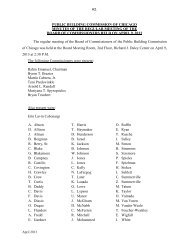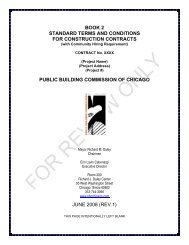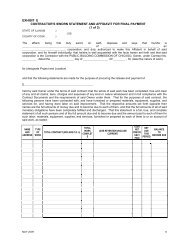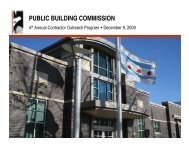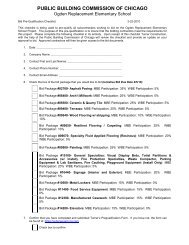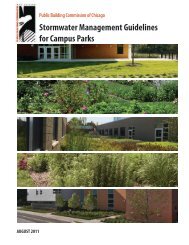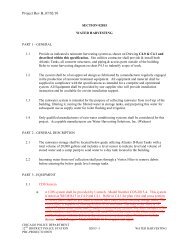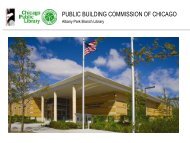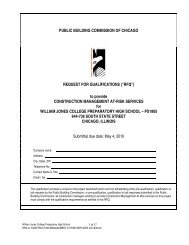Water Reuse Handbook - the Public Building Commission of Chicago
Water Reuse Handbook - the Public Building Commission of Chicago
Water Reuse Handbook - the Public Building Commission of Chicago
Create successful ePaper yourself
Turn your PDF publications into a flip-book with our unique Google optimized e-Paper software.
<strong>Water</strong> <strong>Reuse</strong> <strong>Handbook</strong><br />
20 : <strong>Public</strong> <strong>Building</strong> <strong>Commission</strong> <strong>of</strong> <strong>Chicago</strong><br />
Overflow drain: If <strong>the</strong> storage tank becomes too full, an overflow<br />
drain should be incorporated to funnel excess water to <strong>the</strong> sewer<br />
through means <strong>of</strong> an indirect connection. A u-trap and rodent guard<br />
should be placed in <strong>the</strong> overflow drain to protect <strong>the</strong> supply from<br />
gasses and prevent rodents from climbing back into <strong>the</strong> storage tank<br />
and contaminating <strong>the</strong> harvested water supply.<br />
Ventilation: When chlorination is utilized as a purification method, it<br />
is necessary to ventilate <strong>the</strong> tank room to <strong>the</strong> outdoors to remove any<br />
fumes that might occur. All storage tanks must be vented regardless<br />
<strong>of</strong> <strong>the</strong> purification system used.<br />
<strong>Water</strong> level sensors: The storage tank should contain 2 sensors: (1)<br />
to alert <strong>the</strong> control panel when <strong>the</strong> tank level is high and fur<strong>the</strong>r<br />
rainwater is not needed (additional rainwater will be diverted to <strong>the</strong><br />
sewer until water is needed for <strong>the</strong> system again) and (2) to alert<br />
<strong>the</strong> control panel when <strong>the</strong> tank level is low and municipal make-up<br />
water is needed.<br />
Control panel: A centralized control panel is critical for proper<br />
maintenance <strong>of</strong> <strong>the</strong> system and to bring immediate attention to a<br />
cross-contamination issue. It also may be a useful learning tool in<br />
<strong>the</strong> appropriate setting (such as in a public area <strong>of</strong> <strong>the</strong> building like a<br />
lobby). The control panel may display such items as:<br />
• Volume <strong>of</strong> harvested rainwater<br />
• Volume <strong>of</strong> municipal make-up water used<br />
• Any loss in pressure and its location in <strong>the</strong> system, which may<br />
indicate that a filter needs to be cleaned or o<strong>the</strong>r maintenance<br />
is necessary<br />
• Indicator light for UV system - when bulbs needs replacement<br />
or if <strong>the</strong>re is a problem with <strong>the</strong> system<br />
• Indicator light for chlorination system - if chlorine levels have<br />
fallen below accepted standards, if chlorine is needed, or if<br />
<strong>the</strong>re is a problem with <strong>the</strong> system<br />
Tools and Strategies: Rainwater Harvesting System Design<br />
August 2011



